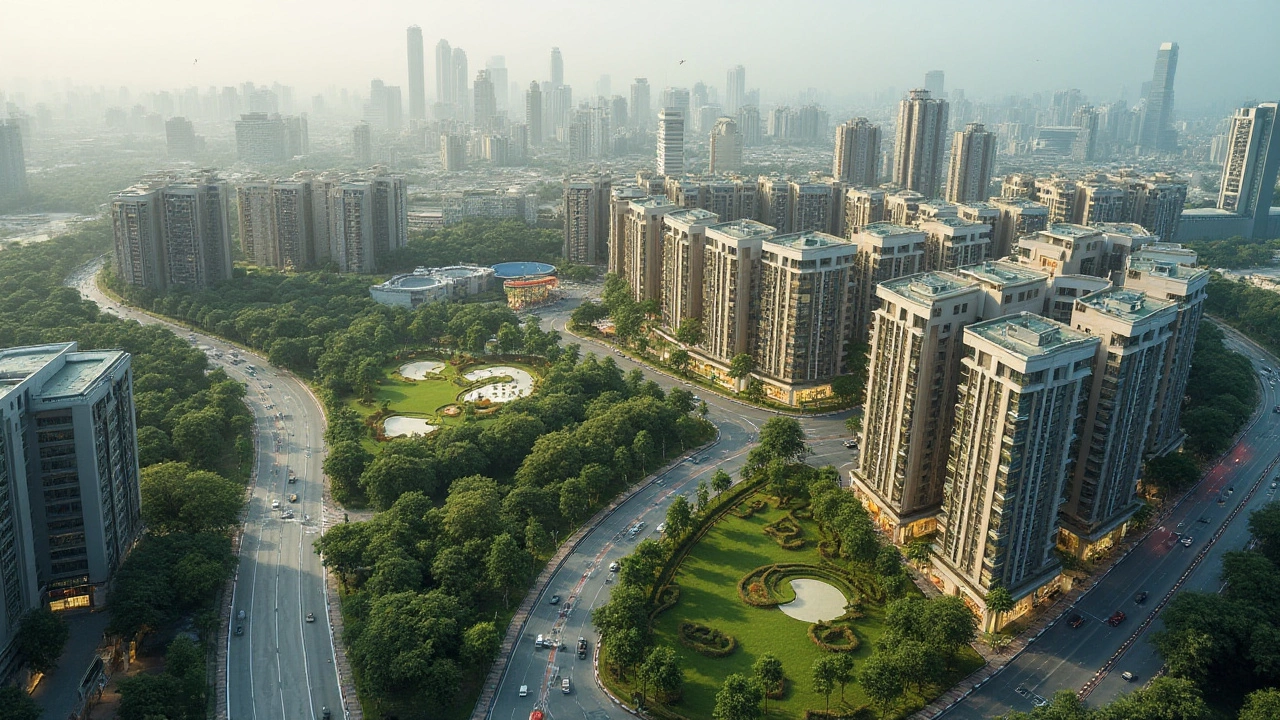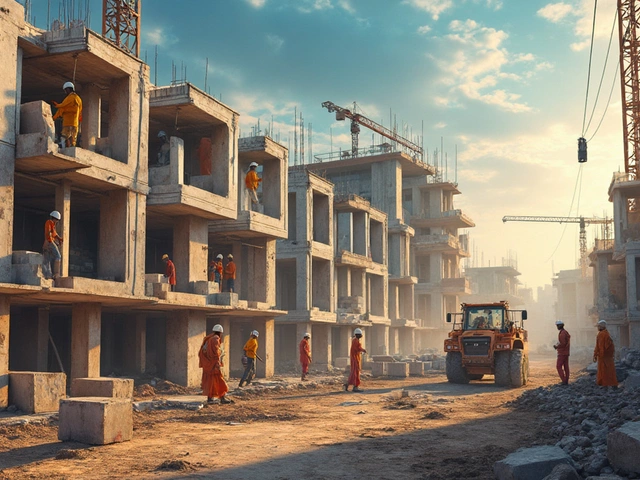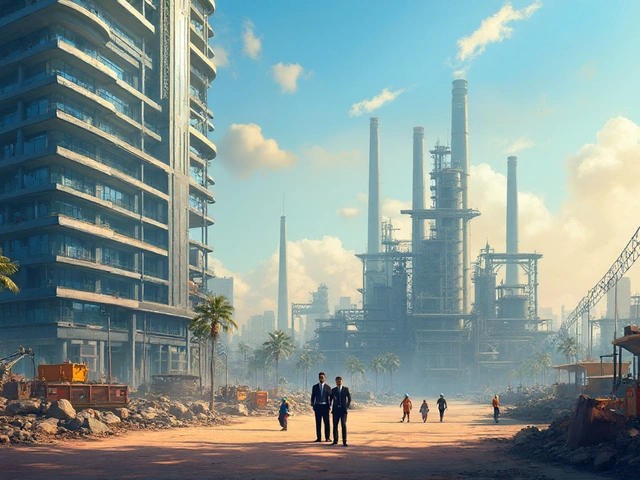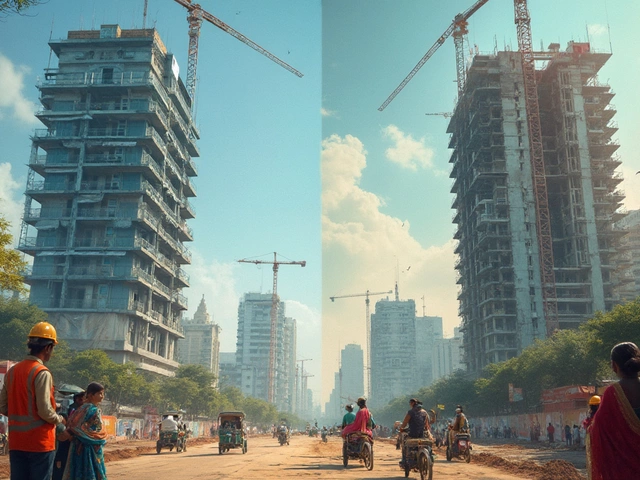The term 'commercial use' in construction refers to buildings or spaces designed to facilitate business operations and services. This might include anything from sleek downtown office towers to bustling shopping centers or sprawling industrial parks.
Grasping the details of commercial use is vital as negligence can lead to legal issues and financial setbacks. It's about aligning the intended use with defined regulations and design necessities.
This article dives into the essentials of commercial construction, offering insights and tips that inform safe and economically beneficial projects. Stay tuned as we unravel the complexities behind a concept that is as pivotal as it is expansive within the construction industry.
- Defining Commercial Use
- Types of Commercial Spaces
- Regulatory Compliance
- Planning and Design Considerations
- Economic Impacts
- Future Trends in Commercial Construction
Defining Commercial Use
When we talk about commercial use in the context of construction, we are referring to the development of buildings and spaces primarily intended for business ventures and activities. These structures are not merely shelters but are designed to house business operations such as stores, offices, and manufacturing units. One of the quintessential examples of commercial use can be seen in shopping malls, where a plethora of businesses coexist, ranging from retail stores to restaurants, each necessitating tailored architectural considerations. Commercial construction requires developers to balance aesthetic appeal with operational efficiency, ensuring that the infrastructure complements the businesses it aims to support. Similarly, office buildings, whether they are skyscrapers in urban areas or more spread-out campus-style developments in suburban areas, are meticulously planned to offer collaborative and functional workspaces that meet the growing demands of modern businesses.
These structures must adhere to specific zoning laws and building codes that govern their construction and usage. Zoning laws determine the kind of activities permissible in a given area. Imagine a chic boutique hotel suddenly sprouting in an industrial zone; such inconsistencies can lead to friction with local planning authorities. Building codes, on the other hand, delve into the safety and accessibility aspects. They mandate earthquake-resistant designs in seismically active areas or dictate the integration of technology in modern buildings for energy efficiency. The nuances of these regulations ensure that the commercial entities housed in these structures operate in a safe, legal, and efficient manner. As John Smith, an urban planner emphasized,
"The intricate weave of zoning and building codes ensures cities grow sustainably while meeting the commercial aspirations of their inhabitants."
To add layers to this understanding, commercial construction often includes considerations for potential future adaptations. Architects and developers might incorporate flexible floor plans or modular elements that allow businesses to expand or change their operational focus without necessitating large-scale renovations. This foresight not only adds value to the building over its lifecycle but also appeals to a more eco-conscious clientele looking for sustainable business practices. Balancing such foresight with present-day needs requires a nuanced understanding of both market trends and construction technologies.
Moreover, the economic implications of defining and developing commercial use properties are profound. They often contribute significantly to local economies by creating jobs, both during the construction phase and as businesses operate within them. According to the National Bureau of Economic Research, commercial construction was responsible for over 2 million jobs creations in the past two decades alone. Such projects not only involve direct hiring but also trigger a domino effect that benefits local suppliers, service providers, and ancillary businesses. Thus, the definition and scope of commercial use often transcend mere physical spaces and morph into engines of community growth and development.
Types of Commercial Spaces
In the vast domain of commercial construction, there's an intriguing array of spaces each serving unique purposes essential for business activities. When people ponder commercial spaces, they often envision bustling urban office towers or expansive shopping malls. However, the spectrum extends far beyond that. Understanding the various types is crucial not only for developers but also for investors and city planners who play key roles in shaping the urban landscape. Each type of space has its particular design and regulatory considerations that must be met to ensure safety and functionality.
Office buildings form a major segment of commercial spaces. Ranging from modest stand-alone structures to towering skyscrapers, these spaces are designed to accommodate businesses of varying sizes and industries. Office buildings can further be classified into categories based on size and occupancy, such as co-working spaces, which have become increasingly popular. These shared environments cater to smaller businesses, freelancers, or startup companies that might not have the resources or necessity for leasing a full office. Developers must consider modern needs, like increased connectivity options or eco-friendly building practices, which are becoming more important in today's market.
Another prominent category is retail space. These can vary vastly from small local shops to sprawling shopping centers and malls. Retail spaces are unique in that they must offer an appealing customer experience while simultaneously providing practicality for both employees and patrons. They require careful attention to design elements like façade and interior layout to maximize foot traffic and sales. Successful retail designs strike a balance between aesthetics and functionality, often incorporating elements like natural lighting and communal spaces to improve customer engagement.
Simon Smith, an expert in architectural design, once remarked, “Great retail design is not just about creating beautiful spaces; it’s about crafting environments where the customer's journey is as seamless as possible.”
Industrial spaces, such as factories, warehouses, and distribution centers, are another facet of commercial use. These facilities are typically less glamorous but equally significant, catering to manufacturing and logistics needs. The design of industrial spaces often has to accommodate heavy machinery, large inventories, and sometimes even integrated production lines. Accessibility is a key factor here, with considerations for transport links, loading bays, and storage facilities. Security and safety regulations are usually more stringent given the nature of operations involved. Therefore, organizing these spaces to optimize workflows while complying with safety standards is a must for any industrial project architect.
The hospitality industry also plays a huge role in commercial construction. Hotels, resorts, and convention centers need to provide comfort and luxury while maintaining efficient serviceability and operation. These spaces require an effective blend of form and function, as guests expect high standards without the sight of behind-the-scenes logistics. Hotels must consider aspects such as room layouts, amenity placements, conference facilities, and energy-efficient systems. As with all commercial spaces, pertinent regulations concerning health, safety, and environmental considerations are mandatory, affecting how these structures are ultimately conceived and constructed.
Each type of commercial space brings along its unique challenges and opportunities. From adapting to changing market dynamics to innovating designs that blend tradition with technology, understanding these diverse categories is essential for those looking to engage in successful commercial projects. With urban centers continually evolving, the future holds countless possibilities for the transformation and diversification of these critical business environments. It is crucial to stay informed and adaptive, ensuring current and future commercial constructions meet their full potential while adhering to current geographical and sociocultural contexts.

Regulatory Compliance
Navigating the labyrinth of regulatory compliance in commercial construction is essential for anyone involved in the industry. Adhering to local, state, and federal regulations ensures that the buildings are not only safe for public use but also legally protected from potential disputes. These regulations often encompass a range of factors like zoning laws, building codes, environmental considerations, and accessibility requirements, each requiring meticulous attention. Commercial use buildings must meet specific structural integrity standards, ensuring everything from proper emergency exits to adequate water, power, ventilation systems, and so much more. Missing even a small detail can lead to significant setbacks or fines, highlighting the importance of thorough planning and execution.
Delving deeper, zoning laws play a pivotal role in determining what type of construction can take place in a particular area. For a commercial project, this might determine whether a new restaurant can be opened in a particular neighborhood or if an office block can be expanded. To comprehensively understand these laws, stakeholders often engage urban planners or legal experts to interpret the zoning maps and ordinances. Such partnerships are crucial since regulatory landscapes often vary significantly from one region to another. Additionally, permit applications are usually required, with specifics dictated by the size and nature of the project. While some areas offer streamlined processes for developers, others might have more rigorous checks and balances, necessitating detailed documentation and often community engagement sessions.
"Building codes are like the DNA of construction; understanding them is crucial for ensuring that a project stands the test of time." - echoed by many industry experts.
An essential aspect not to be overlooked is environmental regulations. In today's climate-conscious world, how a construction project impacts the surrounding environment is under scrutiny more than ever before. From assessing the carbon footprint of a development to ensuring local wildlife isn't disrupted by the construction process, these assessments form an integral part of the pre-build phase. Often, a detailed Environmental Impact Assessment (EIA) is required, which outlines potential impacts and remediation strategies. This not only mitigates potential environmental harm but also helps in positioning the business as environmentally responsible. Moreover, compliance with the Americans with Disabilities Act (ADA) is crucial to ensure that the finished space is accessible to everyone. This can involve specific design considerations such as ramps, signage, or even the width of doorways and hallways.
Economic incentives can sometimes serve as motivation for stringent regulatory compliance. Several governmental bodies offer financial incentives or tax attributes to developers who adhere to green building practices or incorporate specific socio-economic considerations into their projects. These could be in the form of expedited permit processes, grants, or rebates. Engaging with local agencies early in the project timeline can unearth these opportunities, providing financial wiggle room or enhancing the project's appeal to investors. Whether you're an architect, developer, or investor, understanding regulatory compliance not only ensures legal protection but can also pave the way for innovative and sustainable commercial construction projects that meet community needs and expectations.
Planning and Design Considerations
Embarking on a commercial construction project involves a labyrinth of decisions that balance aesthetic appeal, functionality, and compliance with legal regulations. Through effective planning and design, developers can create spaces that maximize efficiency and profitability. Key considerations often start with an understanding of the client's vision and adapting it to fit the geographical and zonal limitations of the site, a process that is as challenging as it is rewarding. It's crucial to have a keen eye for detail, paying attention to how different elements like materials, energy efficiency technologies, and interior designs can influence the final outcome.
Considering the scope of the project, architects and planners must conduct a detailed site analysis to understand environmental factors like sunlight patterns, wind flow, and soil type. These elements play a vital role in the structural stability and energy efficiency of a building. For a commercial use space, the goal is to promote a design that not only adheres to these specifics but also enhances the business's operational efficiency. According to a study by the National Renewable Energy Laboratory, buildings that incorporate passive solar design reduce energy consumption by 30% on average.
Another layer of planning involves considering the long-term adaptability of the space. Multi-purpose designs that allow different floor layouts can future-proof a building, making it desirable for a broader spectrum of tenants. This is pivotal in maintaining a property's value over time. The investment in adaptable design can yield significant returns, as seen in the trend of co-working spaces, which has transformed the traditional office model into flexible hubs of productivity. "Adaptive reuse is what keeps our cities vibrant," quotes Dan Karlin, a renowned urban planner, emphasizing the importance of flexibility in design.
There are additional regulatory hurdles to consider, and they require a thorough understanding of both local and federal legislation revolving around buildings for commercial use. These regulations will dictate everything from fire safety measures to accessibility features required by law. Missteps in this respect can lead to costly project delays and potentially expensive litigation. Thus, engaging with consultants who specialize in regulatory compliance can be an invaluable insurance policy against unforeseen challenges, ensuring that the final structure meets all necessary legal benchmarks.
The financial implications of commercial construction planning are equally noteworthy. Creating a robust financial plan that considers the budget for construction costs, permits, future maintenance, and unexpected expenses is vital. Cost forecasting tools and construction management software can facilitate the process, providing real-time tracking of expenditures and helping managers stay within budget while still allowing for design innovations that can set their building apart in a competitive market.
To summarize, the planning and designing phase for commercial construction is a multifaceted endeavor requiring a balance between innovation and pragmatism. It calls for a deep understanding of both the architectural nuances and the socio-economic impacts of the project. When executed effectively, this phase lays a strong foundation for a project that is not only architecturally sound and legally compliant but also financially viable and environmentally responsible. In the world of construction, the forethought and creativity invested at this stage is what often sets successful projects apart from the ordinary.

Economic Impacts
The realm of commercial construction significantly intertwines with economic dynamics, influencing both macroeconomic and local economic levels. The construction of commercial facilities tends to kick-start growth in economies by generating employment opportunities right from the planning stages through to completion. Hundreds of thousands of jobs are created annually in this sector alone, impacting various professional fields, ranging from architects and engineers to bricklayers and traffic coordinators. Companies with multiple demands for services, such as logistics and supply management, see a boost too, as material procurement relies on efficient supply chains. Additionally, these construction projects often lead to increased demand in local services—restaurants, housing, and retail all benefit from the influx of workers and new business operations.
Significantly, commercial use buildings become long-term contributors to the tax base of a locality, enhancing public resources for infrastructure, services, and education. When a new office park goes up, for instance, it doesn't just bring new amenities; it often significantly adds to a city or town's annual revenue. However, there are instances where economic benefits can be subject to the changing winds of business trends and investor interests. During economic downturns, there's often a deceleration in commercial construction which can lead to reduced economic growth and job loss. This cyclicity makes a balanced understanding essential. As economist Peter Hayes stated, "The commercial construction sector stands as a bellwether for economic vitality, signaling not just the current health but also prospective prosperity and resilience."
The costs associated with commercial construction projects often translate into millions, even billions of dollars. Developers invest substantial funds that ripple through the economy, from initiating contracts with construction firms to local expenditures for materials and labor overheads from local vendors. For investors and stakeholders, understanding commercial use can markedly influence decision-making strategies. Long-term, the project's economic impact manifests in increased real estate value and rising demand for surrounding properties, shaping neighborhood infrastructure and dealing a direct hand in urban development.
Interestingly, we can see indirect economic impacts in the technological advancements spurred by innovation within the industry. Smart buildings, augmented reality design plans, and sustainable construction practices are rising trends that not only influence project costs but also affect global economic standing as they command a premium in investment. The intersection of commerce and construction is visible in trade balances too, where imported materials or international contractors can oust local options, prompting policies that either favor or hinder economic conditions. Understanding these impacts can make a profound difference in how we approach future endeavors in the sphere of commercial construction.
Future Trends in Commercial Construction
Commercial construction is on the brink of a transformation, with new trends emerging that promise to reshape the industry landscape. One major trend is the incorporation of sustainable and eco-friendly practices in design and building materials. Architects and builders are increasingly adopting green building standards to reduce environmental impact and improve energy efficiency. This shift not only caters to the growing demand for sustainable buildings but also aligns with stricter regulatory frameworks aimed at reducing carbon footprints. Many companies are now striving to achieve LEED certification for their structures to demonstrate their commitment to sustainability.
In addition to sustainability, the digital revolution is another significant catalyst for change in the commercial construction space. Technologies such as Building Information Modeling (BIM), virtual reality, and AI-driven analytics are making it possible to create more accurate and efficient construction plans. These tools enhance collaboration among stakeholders, allowing for real-time adjustments and reducing costly delays. An exciting potential lies in the use of 3D printing for constructing components, which not only speeds up the building process but also offers customizability. A report from McKinsey & Company highlights that, "Digital technology can boost productivity in construction by up to 20%."
Robust integration of digital tools not only increases productivity but also enhances safety measures and project outcomes, while minimizing errors and rework.
The trend towards mixed-use developments is also gaining momentum as urban areas contend with space limitations and changing lifestyles. These developments combine residential, commercial, and recreational spaces within a single complex. The goal is to create self-sustaining communities where individuals can live, work, and play, all within the same vicinity. This trend is being driven by consumer preferences for convenience and accessibility, as well as the economic benefits of maximizing land use. The demand for adaptive reuse projects is growing, as developers convert existing, underutilized properties into vibrant mixed-use hubs, breathing new life into aging structures.
Emerging technologies like the Internet of Things (IoT) are another key trend redefining commercial construction. IoT can play a crucial role in smart buildings, allowing for enhanced monitoring and control of systems such as lighting, HVAC, and security. These advancements lead to more efficient energy use, lower operational costs, and improved occupant comfort. Businesses are increasingly adopting IoT solutions to ensure smart management of resources and to optimize maintenance schedules through predictive analytics. Smart buildings are expected to become the norm as more companies seek to enhance operational efficiency and tenant satisfaction.
A potential shift towards increased modular and prefabricated construction is also anticipated. This approach involves constructing sections of buildings in factories under controlled conditions, before being transported to the site for assembly. By streamlining the manufacturing process and reducing on-site labor requirements, modular construction can cut costs and accelerate the timeline of projects. This method demonstrates particular advantages in remote or urban locations where logistics and space constraints pose significant challenges. As labor shortages and material costs continue to rise, modular construction is seen as a viable strategy for overcoming these barriers.
Looking forward, the focus on agile, technology-rich, and environmentally conscious building practices will only intensify. As stakeholders adapt to these trends, the commercial construction landscape will inevitably become more innovative and responsive to the evolving demands of society. Whether it be through digital transformation or sustainable design, the future of commercial construction holds promise for a more efficient, adaptable, and responsible approach to building our world.




Write a comment